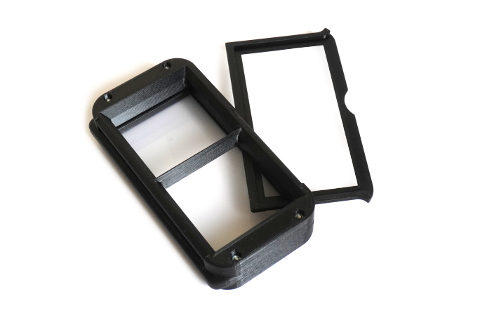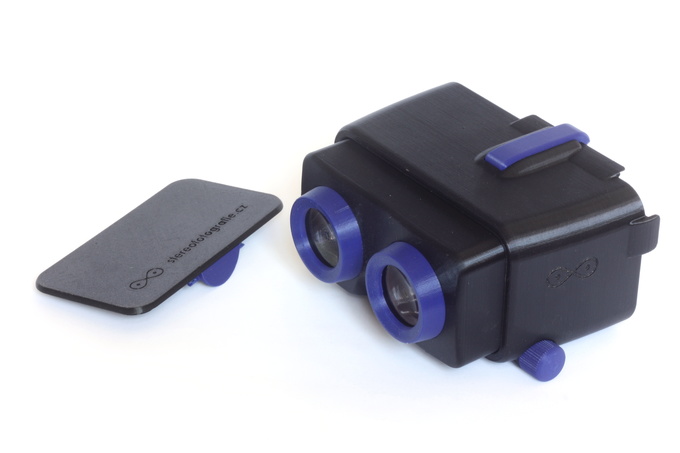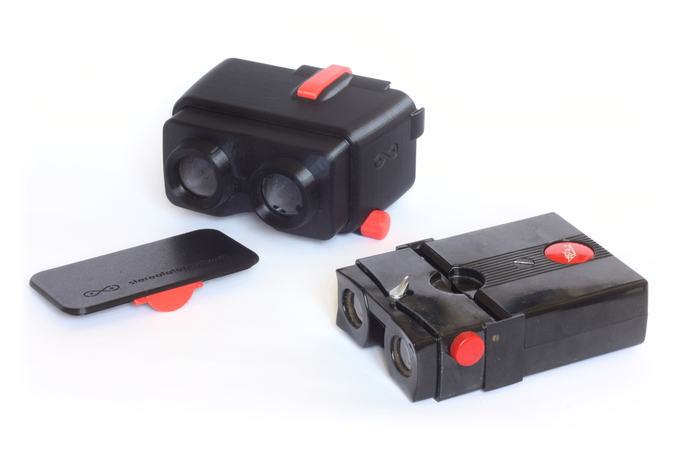
3D-printed Stereoscope
In 2019 I built a wooden stereoscope, using a Sony smartphone with a 4K screen and high quality optics. The interest among fellow stereo enthusiasts inspired me to develop a 3-D printed version which I can now make on demand.
The Stereoscope
Sony Xperia XZ Premium phone
Medium Format Attachment
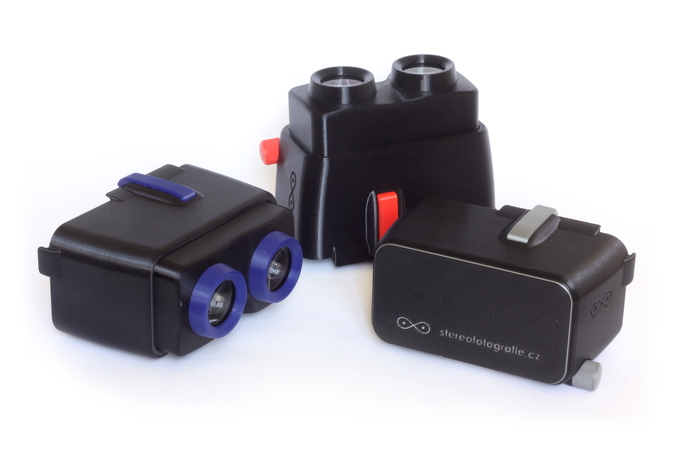
The Stereoscope
Design Of the Viewer Body
The body of the viewer is designed to be as compact as the phone and optics allow. The focusing mechanism is used to fully retract the lens part when the viewer is not in use. The outer shell can then be closed with a lens cover (held by a spring mechanism) and the closed viewer becomes a solid box.
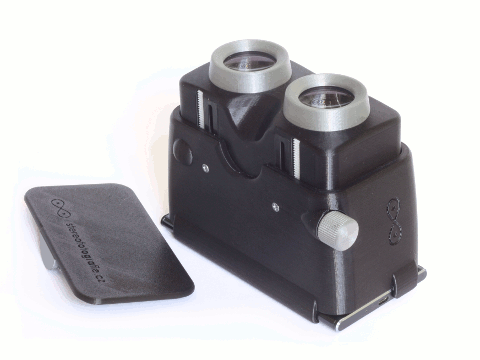
The phone is inserted in a groove at the bottom and securely held by a lever with a steel spring.
The 3D-printed parts are made from PLA (Polyactic acid). One disadvantage of the material is sensitivity to high temperatures - the viewer should not be exposed to temperatures above 60 °C (a closed car in summer etc.).
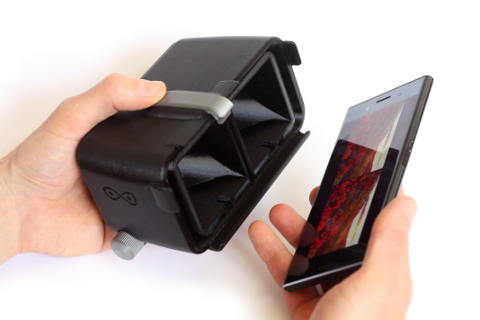
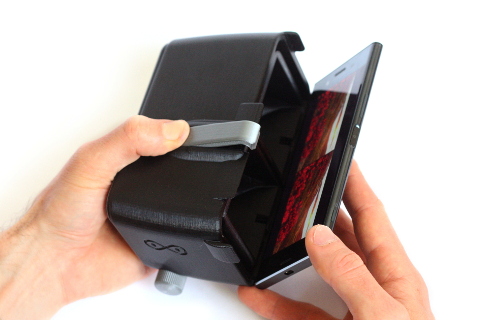
Lenses
I use high quality achromatic doublets from Jeroen de Wijs, with 100 mm focal length and 33 mm diameter.
I consider this focal length to be ideal for traditional stereoscopic photography. The majority of current viewers and especially virtual reality sets use wider viewing angles, primarily to achieve immersion. But I prefer to clearly see the stereoscopic window and the whole composition of the image. 100 mm FL with a screen of this size is very close to the viewing angles of slide viewers from the film era. Viewing the images with longer FL lenses is also more relaxing to the eyes and the lower magnification suppresses optical imperfections.
Alternatively, I can supply cheap single element lenses. You do see chromatic aberation in the images when you search for it, but at this low magnification it is less apparent than I would expect. Many people cannot see it or do not care about it. I have these lenses in a "back-up" viewer, but I definitely consider the quality archromatic optics to be a worthwhile investment.
Focusing
The viewer has a rack and pinion focusing mechanism, with brass pinions, a stainless steel shaft and a knurled knob on the right hand side. Friction in the focusing mechanism can be adjusted by slightly loosening or tightening two Phillips screws (PH1) at the bottom of the viewer.
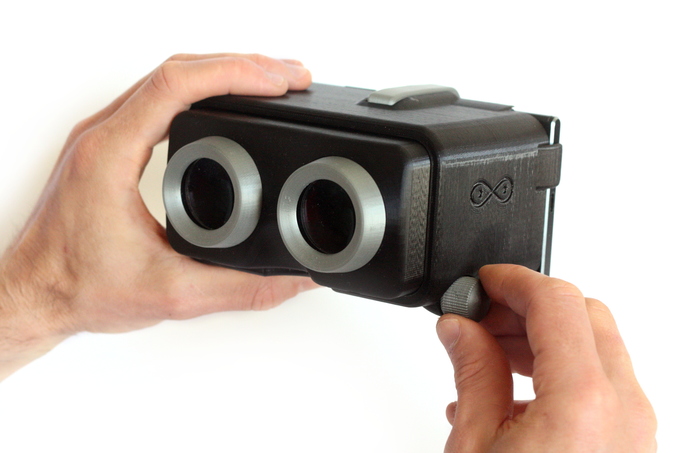
Interocular Distance
The interocular distance is fixed at 63 mm. This distance corresponds to the far-point spacing on a screen of this size (at 3.3 % deviation).
I decided to omit interocular adjustment after the experience with my "prototype" viewer, which did have it. 63 mm proved to be convenient with all users, including children. The mechanism adds to the complexity, size and the extra setting tends to confuse inexperienced users.
Sony Xperia XZ Premium phone
Preconditions For Stereo
Availability of smartphones with very high resolution displays was a milestone in stereoscopic viewing. There are two discontinued models of Sony smartphones with a 4K screen of the optimal size (~122 mm wide): "Sony Xperia Z5 Premium" and "Sony Xperia XZ Premium". The resolution of the display allows viewing under appropriate magnification without seeing any pixels and the size of a displayed image pair corresponds to the human eye spacing. For the time being (written in 2020), there does not seem to be a better alternative - the only other 4K phone introduced since then has a screen that is too wide for the purpose.
The viewer is designed specifically for the later "XZ Premium" type. According to the marketing the screen should be further improved over the earlier "Z5" model (HDR technology). In 2020 the XZ Premium phone can still be occasionally bought new, refurbished or used. But this could not last long and it might be wise to get the phone as early as possible - new, equally suitable devices are yet to be seen on the market.
Herringbone Pattern
Despite the otherwise excellent characteristics, the phone display has one perceivable imperfection. The individual pixels are indeed invisible, but a close examination under high magnification reveals that the RGB pixels are not arranged in a perpendicular grid but rather in a "herringbone pattern". The pattern can be sometimes perceptible in larger uniform areas of a light colour.
The stereoscope has a slightly narrower viewing angle than most similar viewers, making the herringbone pattern less apparent. It is barely noticeable in most images, according to my experience.
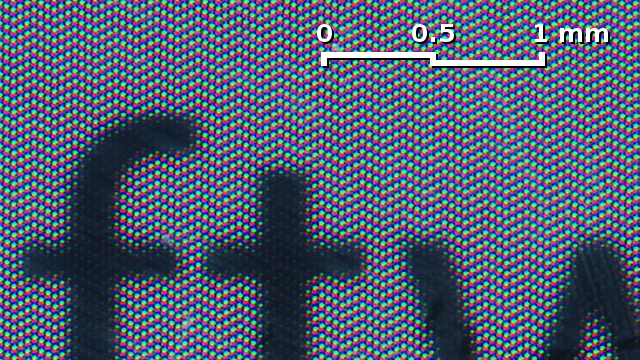
Photo by Miroslav Kopeček
Switching the Phone To 4K
With the usual (factory) settings, the phone's display is only using a quarter of the native resolution most of the time (FullHD). Only specific applications take advantage of the full resolution - namely the video viewer and the default "Album" image viewer. However, the phone can be switched to 4K entirely and permanently and this needs to be done to be able to use the hardware volume button on the side of the phone to navigate through the image folder (the screen cannot be touched while the phone is mounted in the stereoscope and the "Album" application does not allow any other control).
The change cannot be done in the common user interface. See step-by-step instructions on a separate page.
There can be some issues with ordinary phone functions with these settings (phone calls), but neither of them matters if you intend to use the phone only in the stereoscope.
Image Viewing Application
With the phone switched to 4K, any image viewing application can be used. I can recommend the "stereoscope" by Pierre Meindre.
Although the "stereoscope" application has advanced settings, I prefer to copy the images from the computer as side-by-side *.jpg files, scaled to 3840×2160 px, with a narrow black spacer (18 px) inserted in the middle (see example). The export can be done in StereoPhoto Maker. I use my own primitive script to make the conversion.
Medium Format attachment
An attachment can be supplied to allow using the stereoscope for viewing medium format slides. It is designed to clamp in place of the phone. Although the image plane is shifted by about 16 mm, the focusing range is long enough to cover this.
Alternatively, a slightly different viewer body without the phone holder can be printed, creating a more elegant single-purpose medium format viewer.
So far the attachment uses available light only. There is a battery powered lighting panel under development.
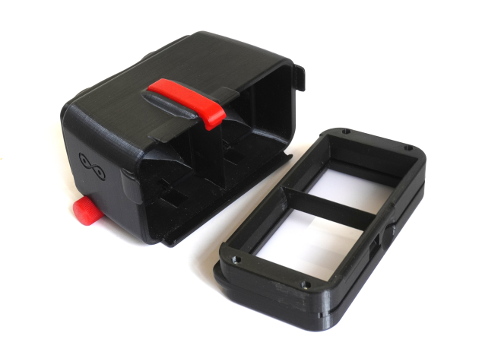
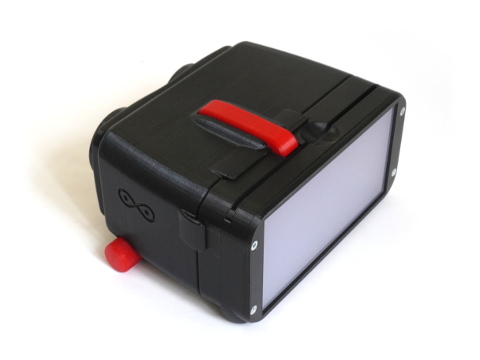
The slide holder is designed to accommodate both common sizes of MF slide mounts - either 140 mm (3D World) or 132 mm wide - an inserted adaptor is used to centre the latter both vertically and horizontally.
